The Blue Black Cherries Moon Looks Brown, Bright Planets’ Satellites Sparkle, and the Dragon’s Bright Lights!
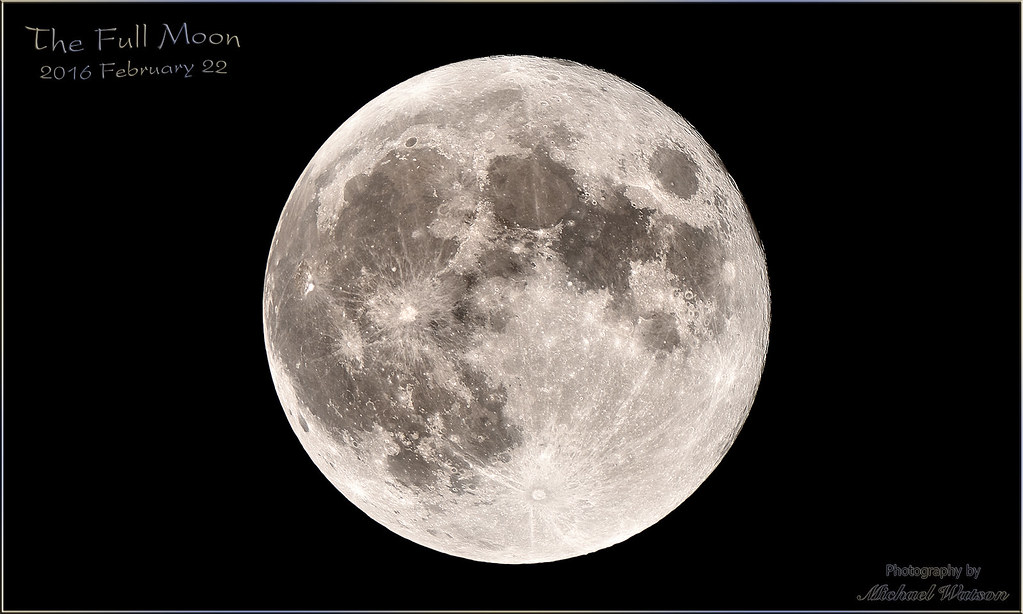
This photograph of the moon by Michael Watson of Toronto was taken 9 hours after its full phase. It will closely match the appearance of the moon after it rises on Sunday night, August 22 in the Americas. A thin strip along the moon’s right-hand limb will already be darkening, and the craters there will show some shadowing. Enjoy more of Michael’s images at https://www.flickr.com/photos/97587627@N06/
Hello, late-August Stargazers!
Here are your Astronomy Skylights for the week of August 22nd, 2021 by Chris Vaughan. Feel free to pass this along to your friends and send me your comments, questions, and suggested topics. You can also follow me on Twitter as @astrogeoguy! Unless otherwise noted, all times are expressed in Eastern Time. To subscribe to these emails please click this MailChimp link.
I can bring my Digital Starlab portable inflatable planetarium to your school or other daytime or evening event, or teach a session online. Contact me through AstroGeo.ca, and we’ll tour the Universe, or the Earth’s interior, together!
Today’s blue full moon will flood evening skies with light to open this week, then it will rise much later by week’s end. I share some moon-friendly targets in Aquila and Draco and update the surprise nova outburst in Ophiuchus. And every Earthling can enjoy the bright planets Venus in evening, and Saturn and Jupiter all night long – and their moons! Read on for your Skylights!
I Co-authored a Book!
I generally don’t like self-promotion, but I’m really proud of a new book John A. Read and I released at the end of July. It’s called 110 Things to See With a Telescope, in paperback and hardcover. It’s a guide to viewing the deep sky objects in the Messier List – for both beginners and seasoned astronomers. The first section is a full of tips for astronomy. The rest covers the objects season by season, with simple sky charts. Many of the objects can be seen with binoculars, too. We spent a great deal of effort to make it easy to use, accurate, and informative. I hope you like it! Here’s the cover and a sample page.

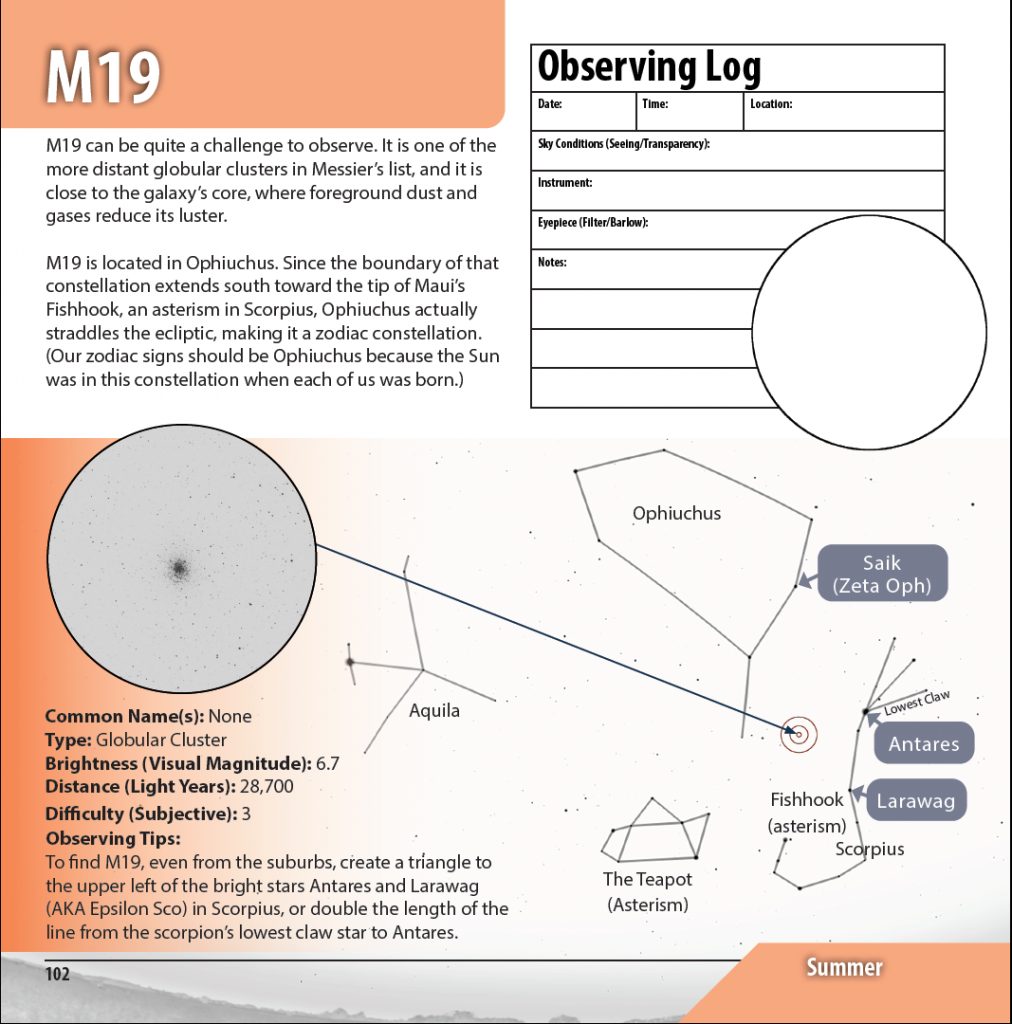
The Moon
The August full moon officially occured this morning (Sunday) at 8:02 am EDT or 12:02 GMT. This one is colloquially called the “Sturgeon Moon”, “Black Cherries Moon”, “Green Corn Moon”, and “Grain Moon”. I wrote about it last week here. By the time the moon rises on Sunday night in the Americas, it will already be starting to wane. Magnified views will reveal a thin strip of darkness, and some craters with shadowed rims, along the moon’s right-hand (eastern) limb.
The media are calling this a Blue Moon. In a calendar year, the moon completes 12.36 cycles of its phases, also known as its synodic period. That means that every third year (give or take) contains 13 full moons instead of 12. The extra full moon is “blue” if a) it’s the third full moon out of four within a season, or b) it’s the second full moon within the same calendar month. Today’s is the third full moon during summer, 2021. The others are June 24, July 24, and September 20. That one will occur just 43 hours before the September equinox and end of summer.
The second definition of Blue Moon is my preferred one – it’s fun – but astronomers don’t really pay attention to them, either way. What is important to remember is that blue moons DON’T LOOK BLUE! Instead, you’ll probably observe that tonight’s moon is tinted brown or orange by the forest fire smoke particles in the air. (The smoke also spoils stargazing by dimming everything.)
Sunday night’s moon will also be situated a generous fist’s diameter to the lower left (celestial southeast) of Jupiter, allowing you to confirm your Jupiter-sighting! For the rest of this week, the moon will wane and rise later as it decreases its angle away from the sun. (It will be approaching the sun from the pre-dawn side.) After spending Sunday and Monday among the faint stars of Aquarius (the Water-Bearer), it will swim along the crooked boundary between Pisces (the Fishes) and Cetus (the Whale) until Thursday. On Friday night the still-gibbous moon will pass through southern Aries (the Ram) – a few finger widths to the lower right (celestial south) of Uranus. That’s their second meeting this month. They’ll be close enough to share the view in binoculars. While the blue-green dot of Uranus can be seen with your unaided eyes from a dark sky location and in binoculars from the suburbs, it’s a good idea to note the planet’s location between the stars of Aries and Cetus and hunt for it on a night when the bright moon has moved away.
The moon will spend the coming weekend near the Pleiades star cluster and the rest of western Taurus (the Bull) – but you’ll need to stay up past midnight, or rise before dawn, to see it. As a matter of fact, the moon will be shining in the morning daytime sky from Tuesday onwards.
The Planets
Venus, Jupiter, and Saturn are eye-catching planets in the evening sky. Venus will emerge from the post-sunset twilight after about 8:30 pm local time, and then it will set in the west just before 10 pm. You might need to walk around until you find an open view to the west. Venus will not be much higher than the trees and rooftops. When viewed in a backyard telescope Venus will exhibit a smallish, featureless disk and a football shape because it’s only 75%-illuminated right now. Aim your telescope at Venus as soon as you can spot the planet in the sky (but ensure that the sun has completely disappeared first). That way, Venus will be higher and shining through less distorting atmosphere – giving you a clearer view.
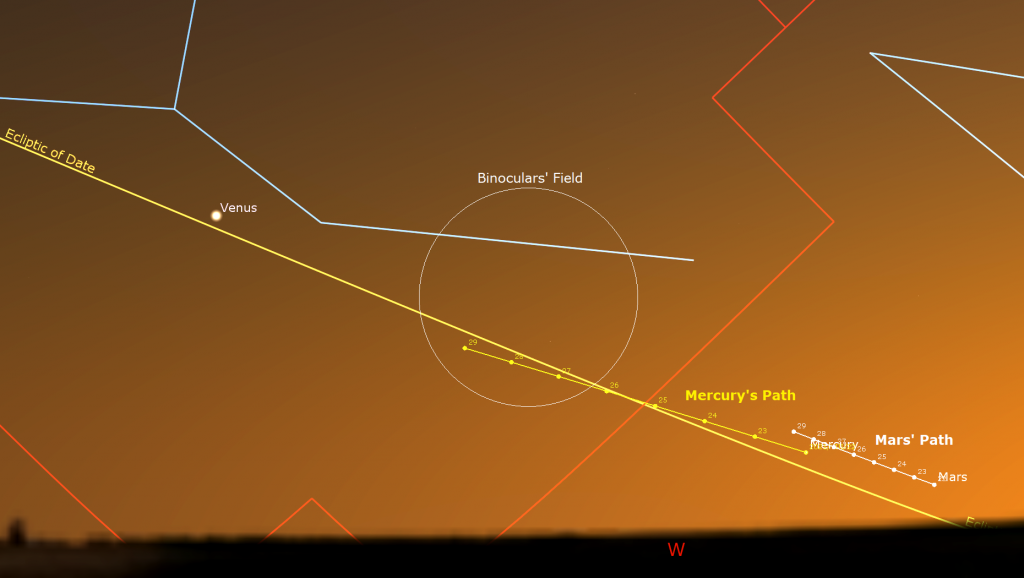
Much fainter Mercury will be shining just a few finger widths above the western horizon after sunset, too – but the twilight and clouds or haze will make it tough to see. Fainter Mars is down there, too – to the lower right of Mercury. Observers who live in the tropics or the Southern Hemisphere will see Mercury (and Venus) easily, in a dark sky. Maybe Mars, too!
This week, Jupiter and Saturn will already be just above the southeastern horizon at sunset. The low position of the ecliptic on August evenings will keep those planets from rising very high. Even when they culminate on the meridian (i.e. reach their highest position, directly over the southern horizon), they’ll only reach 27° elevation. That’s less than a third of the way up the sky.
Yellow-tinted Saturn will set in the west-southwest at about 4:30 am local time this week. Sixteen times brighter Jupiter, which will be positioned about two fist diameters to Saturn’s left (celestial east), does the same thing 90 minutes later.
Saturn’s axial tilt of 26.7° (a bit more than Earth’s 23.5° tilt) lets us see the top of its ring plane, and allows Saturn’s brighter moons to be distributed all around the planet. During this week, Saturn’s largest and brightest moon Titan will migrate counter-clockwise around Saturn, moving from the lower right (celestial east) of Saturn tonight to the upper right (celestial west) of the planet next Sunday. (Remember that your telescope will probably flip the view around.)
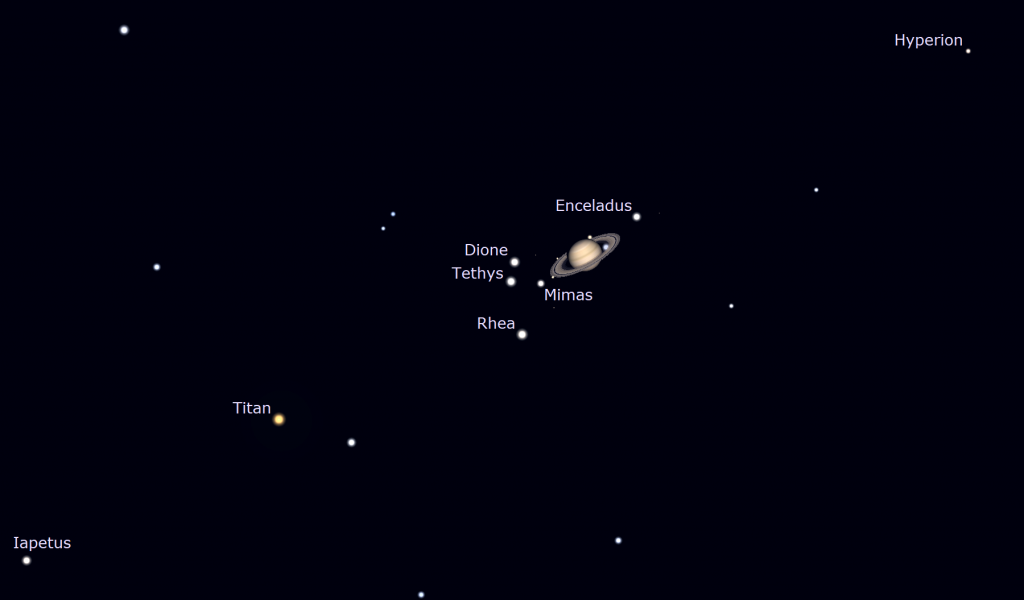
Titan never wanders more than five times the width of Saturn’s rings from the planet. Much fainter Iapetus can stretch to twelve times the ring width. Iapetus is dark on one hemisphere and bright on the other. So it looks dimmer when it is east of Saturn (as it is this week), and it looks brighter when it is west of Saturn (as it will be during the middle of September). The moons Rhea, Dione, Tethys, Enceladus, and Mimas stay within one ring width of Saturn. How many of the moons can you see in your telescope?
Binoculars and small telescopes will show you Jupiter’s four large Galilean moons named Io, Europa, Callisto, and Ganymede. Since Jupiter’s axial tilt is a miniscule 3°, those moons are always strung like beads along a straight line that passes through the planet and parallel to Jupiter’s dark equatorial belts. The moons’ arrangement varies from night to night.
If you have a small telescope, use it on Jupiter this week. Since opposition was last Thursday, the planet is still almost its closest and brightest for 2021! I was viewing it through the 74” diameter telescope at the David Dunlap Observatory that night! Use blue or green coloured filters to enhance Jupiter’s features.
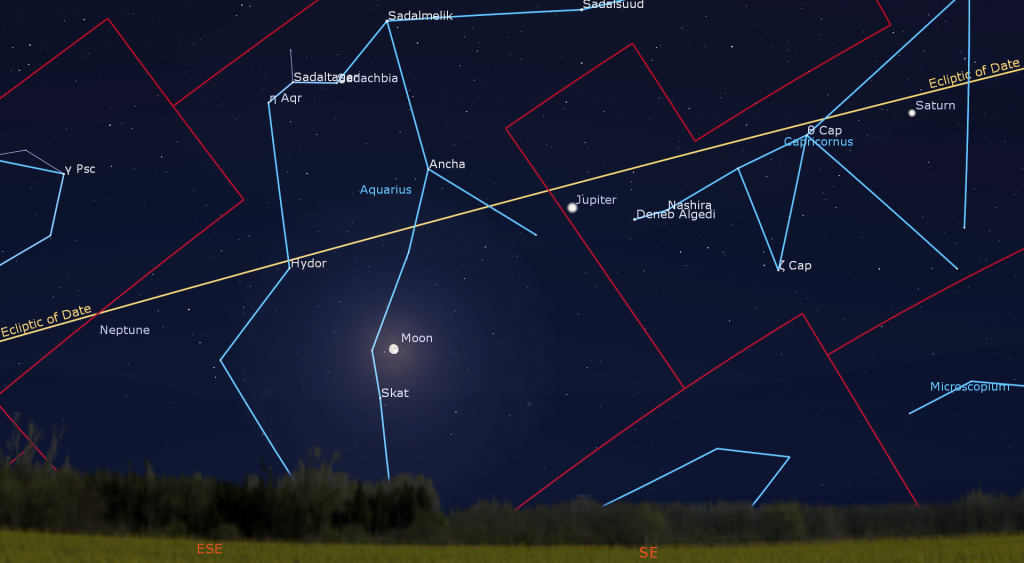
For observers in the Eastern Time Zone with good telescopes, the Great Red Spot (or GRS) will be visible crossing Jupiter on Tuesday, Thursday, and Sunday evening, late on Monday, Thursday, and Saturday night, and before dawn on Monday, Wednesday, and Saturday morning.
From time to time, the small round black shadows cast by Jupiter’s Galilean moons become visible in amateur telescopes when they cross (or transit) the planet’s disk. Europa’s shadow will cross on Thursday morning from 3:10 to 6 am EDT, Io’s shadow will be visible on Thursday night from 11:45 pm to 2 am EDT, and Ganymede’s shadow will transit on Sunday evening, August 29 from dusk until 10:20 pm EDT.
Dim, blue Neptune is located near the border between Aquarius and Pisces (the Fishes) – about two fist diameters to the left (or 25° to the celestial east) of Jupiter. Neptune rises at about 9 pm local time and reaches peak visibility halfway up the southern sky at 2:45 am local time. It will rise and culminate about half an hour earlier each week.
This week Magnitude 5.7 Uranus will rise at about 10:45 pm local time. It will spend all this year parked below Hamal and Sheratan, the two brightest stars in Aries (the Ram). Uranus is currently surrounded by the moderately bright (5th magnitude) stars Sigma, Omicron, Pi, and Rho Arietis – creating a distinctive asterism for anyone viewing Uranus in binoculars.
The Eagle and the Dragon
Last week here I talked about bright things to look at while the moon shines in the evening sky, like stars. Here are a few more suggestions…
The most southerly of the Summer Triangle asterism’s corners is marked by Altair – the head of the great eagle Aquila. At only 16.8 light-years distant, Altair is one of the nearest bright stars (magnitude 0.75) – so close that its surface has been imaged! The star also seems to be spinning 100 times faster than our sun, probably generating an equatorial bulge. The magnitude 2.7 star Tarazed (or Gamma Aquilae) is positioned a thumb’s width above (or 2° north-northwest of) Altair. This orange, K3II-class star is 395 light-years-away. It is young, but highly evolved – already burning core helium. The Magnitude 3.7 star Alshain is located a thumb’s width below (or 2.7° south-southeast of) Altair. This 44.7 light-years-away, yellowish G8IV-class star has also exhausted its core hydrogen and is evolving into a giant. Those two stars sit on either side of Altair, like an old-fashioned scale balance, the device those two names derive from.

Draco (the Dragon) was one of Greek astronomer Ptolemy’s original 48 constellations, and is circumpolar for mid-northern latitudes – it never sets! Its sinuous body winds between the dippers, and the ring of four stars that form its head sits north of Hercules (the Hero) and the very bright star Vega. The dimmest of the head stars Kuma (Nu Draconis) is an easily split double star. Other nice double stars include magnitude 2.8 Eta Draconis (or Athebyne) and magnitude 5.5 Mu Draconis (or Alrakis). The star Thuban was Earth’s pole star for Ancient Egyptians and will again take a turn in AD21000. The northern polar axis of the sun (and of most of the planets in our solar system) points at the star Altais (Delta Draconis).

A New Star – Sort of – Update
On August 8, an amateur astronomer in Ireland named Keith Geary observed that a faint 11th magnitude red giant star named RS Ophiuchi had suddenly flared in brightness – to magnitude 5. That’s 400 times brighter! RS Oph (for short) has a habit of doing that – it’s a rare recurrent nova. Astronomers have recorded about eight of its outbursts since 1898 – but it hadn’t flared since 2006. I discussed it and showed sky charts here. This week it has dimmed all the way down magnitude 8.5, which is still just within reach of binoculars and easy for backyard telescopes. There’s a great article from Sky & Telescope here.
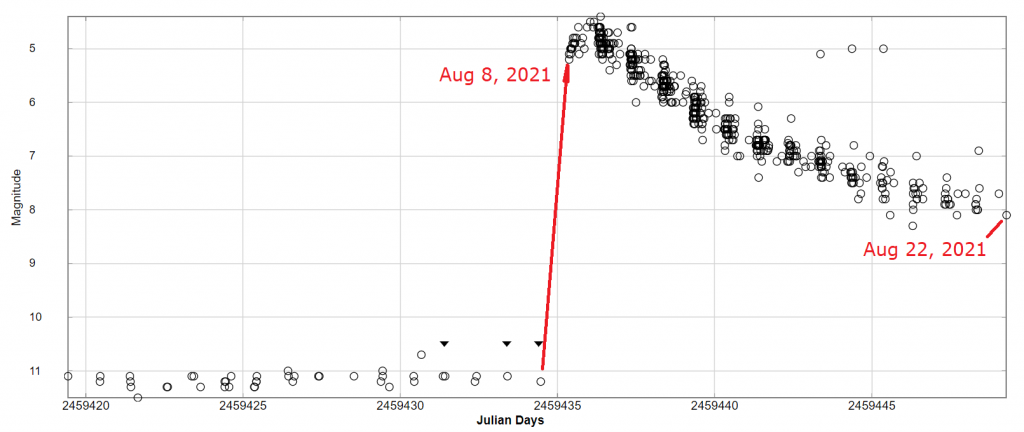
Public Astro-Themed Events
Every Monday evening, York University’s Allan I. Carswell Observatory runs an online star party – broadcasting views from four telescopes/cameras, answering viewer questions, and taking requests! Details are here. Their in-person Wednesday night viewing has been converted to online via the observatory YouTube channel.
Don’t forget to take advantage of the astronomy-themed YouTube videos posted by RASC Toronto Centre and RASC Canada.
Curious about cosmology? At 6 pm EDT on Wednesday, August 25, Catch U of T’s Astronomy & Space Exploration Society’ (ASX) free online Star Talk entitled Pursuing Multiple Lines of Enquiry into Cosmic Dawn and Cosmic Noon by postdoctoral researcher Dr. Dongwoo Chung. Details and the Zoom link are here.
My free, family-friendly Insider’s Guide to the Galaxy webcasts with Jenna Hinds of RASC National will return on Tuesday, September 14 with our recommended astronomy and space books. You can find more details and the schedule of future sessions here. Note: If you registered for the Zoom series last year, you will have received an email asking you to please re-register before Tuesday. (We’re cleaning out older unused registrations to make room for new viewers from libraries across Canada this fall.)
Keep looking up, and enjoy the sky when you do. I love questions and requests. Send me some!